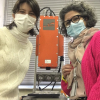
The Universidad Carlos III de Madrid (UC3M) has patented a new system for capturing hyperspectral images, which can operate in real time and provides a higher resolution than any other existing technology. This development could mean a breakthrough for scientific and industrial applications related to chemical analysis.
This system, patented by UC3M’s Sensors and Instrumentation Techniques group, is made up of a light source that transforms a normal camera into a hyperspectral camera. This technology makes it possible to obtain complete characterisations of the chemical composition of the sample being analysed, by measuring the optical absorptions or molecular resonances that are characteristic of each compound. To do this, an advanced analytical technique known as dual-comb spectroscopy is used.
Dual-comb systems work by interfering light from two optical sources, called optical frequency combs. This mixing process generates an interferogram, at a speed that, until very recently, was too fast to be captured even by very high-speed cameras.
The research team for this patent has developed a system based on a dual-comb electro-optical source made with fibre optic components. The main part is a dual-comb illuminator capable of generating two frequency combs that interfere at much lower frequencies than can be obtained with other systems. This makes it possible to detect that signal with any camera that has sensitivity in the emission range of the dual-comb system used. In addition, it is capable of working in different frequency ranges (near infrared, mid-infrared and terahertz).
The technologies based on frequency combs used to date made it possible to analyse a single point of the sample, towards which the light source was sent. The system patented by the UC3M research team makes it possible to spectrally analyse the entire sample and is pioneering in terms of the measurement used because it uses a dual frequency comb instead of the spectral interrogators that current hyperspectral cameras are equipped with.
From this characterisation it can, in addition to identifying the compound, analyse other parameters such as its temperature, pressure and concentration. “The need arises from the shortcomings of current technologies, in which the measurements are very slow and optical absorptions are not identified precisely enough. The high optical resolution with which we can characterise the entire sample with our technology is essential when we work, for example, with gases”, says Pedro Martín Mateos, lecturer in UC3M’s Electronic Technology Department and project researcher.
This system makes it possible to analyse the chemical composition of a complete sample and can be used in many sectors. To date, it has been tested for the detection and analysis of gases, as well as for studying the characteristics of different foods and materials, such as plastic. “We have already demonstrated its usefulness for the study of gaseous samples. This would be useful for the development of more efficient burners or for safety issues. We have also used it for the analysis of certain foods and even for drying wood, and we are starting to develop a system that will allow us to monitor combustion processes with new fuels or alternative fuels, such as hydrogen”, concludes the researcher.










